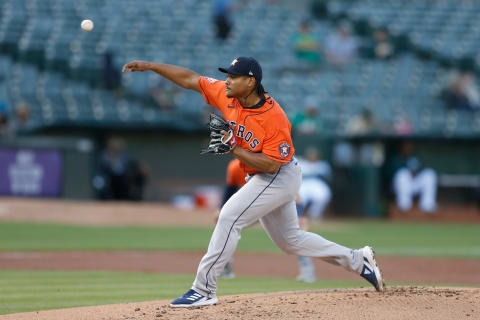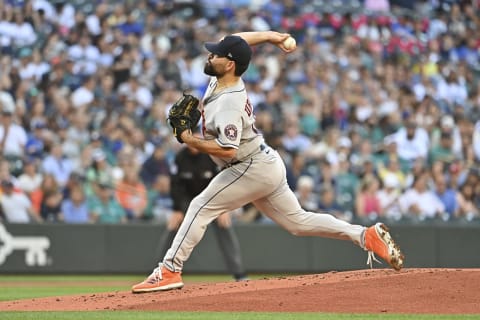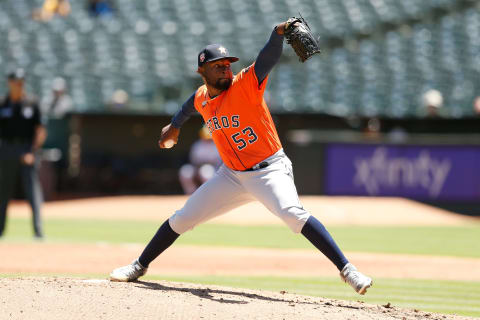If the Astros Will Trade a Starter, Who Should it Be?

In their quest for a position player, the Houston Astros are reportedly willing to trade a controllable starting pitcher. Who is the right one to move on from?
For many teams, the trade deadline often comes with excruciatingly tough decisions, and the Houston Astros have a big one to make. They are reportedly willing to deal a starting pitcher with team control to acquire a position player who also has team control, and considering that they will have 7 starters on their MLB roster when Lance McCullers Jr. completes his rehab assignment, there are a great many ways they could go about this process.
McCullers was recently signed to a long-term extension that would keep him in Houston until 2027, so excluding him, the Astros have 4 starters with team control on their roster. The catch is that all 4 of them are above-average pitchers with postseason experience, and not much separates them in terms of their career stats. If he can lock in on a controllable position player that he wants, GM James Click and his front office are going to be tasked with determining which one’s absence would hurt the Astros the least, which is far from easy.
As a result, I’m going to try to determine who to trade if I were in Click’s position. The choices are going to be Luis Garcia, Jose Urquidy, and Cristian Javier. Due to the fact that he has been the most consistent of the group so far (and since he’s the only left-handed pitcher on the staff), I am considering Framber Valdez untouchable. He has established himself as the clear #2 in this rotation behind Justin Verlander and will almost certainly take the reins long-term, so he should not be in consideration in any trade talks.
As well, Jake Odorizzi was not considered for this piece. He’s easily the most expendable pitcher the team has, but his contract is up after this year, meaning he likely wouldn’t cut it in a trade package for a controllable position player on a non-contender.
With that, let’s dive into the case for and against trading each expendable and controllable starter, beginning with Luis Garcia.

Luis Garcia
Garcia is one of the many pitchers on this staff who debuted in the shortened 2020 season. For his career, he has a 3.57 ERA in 267 innings, and while he was occasionally used out of the bullpen in 2020 and 2021, he has been a full-time starter in 2022. Looking at this season only, he has a 3.81 ERA, 3.37 xERA, 4.16 FIP, 1.08 WHIP, and 107 strikeouts in 99.1 innings. In the grouping of himself, Urquidy, and Javier, he ranks 2nd out of 3 in every single one of those categories.
He has been able to maintain the same swing-and-miss stuff as he did last year, but the home run ball has hurt him a lot more than it did in 2021 (17 home runs allowed in 2022, only 2 fewer than last year in about two-thirds of the innings). He’s allowing less quality contact overall, and the amount of traffic on the base paths is lower than it was, but opponents are barreling up his pitches – which, again, is the best kind of contact a hitter can make – a little too much for comfort.
He strikes out more than a batter per inning, which is always a plus, and unlike Cristian Javier, he doesn’t walk a lot of batters to go along with that. The biggest knock against him is that, while Urquidy has bounced back big-time from a rough start to the year and Javier has made great strides compared to his 2021, Garcia is the only young pitcher on the staff (including Valdez) that has not shown marginal improvement compared to last year, and while he still has room to grow at age 25, every other Astro in this boat has expanded their ceiling as of late.
Garcia was the one that was put into the biggest games of the Astros’ season a year ago with Verlander and McCullers unavailable, and that includes Game 6 of the World Series against the Braves, but he did not deliver, posting an 8.04 ERA in 5 postseason starts. While a 25-year-old’s postseason track record should not be taken highly into consideration in trade talks, his is worse than both Urquidy’s and Javier’s. In all, Garcia is a consistent and talented young pitcher, but questions about his ceiling have made his long-term value to the Astros (in comparison to their other young arms) somewhat blurry.

Jose Urquidy
As it stands, Urquidy is seen as the most likely of this group to be involved in a trade, because he’s slightly older and his stuff is not in the same tier as Garcia’s or Javier’s. Which, of course, also means he just has to be the one that’s the hardest to evaluate. On the year, he has an ERA of 3.86, an xERA of 4.72, a FIP of 4.42, a WHIP of 1.21, and 80 strikeouts. Both Garcia and Javier rank above him in all those categories.
However, Urquidy is the one that has thrown the most innings out of the group, at 107.1. He started in the Majors as a starter with an innings limit, and was used almost exclusively out of the bullpen in his first postseason, but he has thrown 95 pitches or more in most of his outings over the past 6 weeks. Dusty Baker and his coaching staff have transformed him into a workhorse starter.
A caveat with Urquidy is the fact that he is, both in effect and in reality, a different pitcher than he was to start the year. Like many pitchers, he tried to join the “cutter revolution” and add that pitch to his repertoire, but it just was not working. Opponents didn’t end up doing too much damage off it, but they surely would have if he kept sticking with it. Hitters put up a .396 xwOBA against it, meaning they squared it up a ton. He dropped it in early June, and in 8 starts since, he has a 2.60 ERA, 3.89 FIP, and a .163 batting average against. Both the ERA and BA against rank 2nd on the staff over that timespan. The version of Urquidy that we have seen since that change is far more reflective of his abilities than the way he pitched in April and May.
Still, as evidenced by the high difference in ERA and FIP over that timespan, dropping the cutter has only limited the quality of contact against, not the amount. He is still striking out just 6.4 batters per 9 innings since dropping his cutter. The drop in opponents’ average has allowed him to go deep into games of late, but that rate of strikeouts shows that his ERA isn’t necessarily sustainable. As well, his xFIP over that timespan is in the mid-4s, meaning that he has given up an unnaturally low amount of homers relative to the amount of flyballs he has surrendered.
Another complication with Urquidy is the fact that he recently changed agents and hired Scott Boras to represent him. Boras’s aggressive nature in negotiating means that getting paid what he wants as he goes into arbitration will be a top priority for Urquidy, and it will give the team less flexibility if they keep him around. Urquidy has been rightfully credited for his recent contributions out of the rotation after making a key adjustment, and his 1.54 career ERA in the World Series is something that any team would value, but his strikeout stuff is a clear cut below the Astros’ other trade options.

Cristian Javier
Javier is also hard to trade because he has had a big breakout season. However, he doesn’t come without flaws and is in the midst of a less than impressive stretch (4.56 ERA, 7 HR allowed in July). That said, his season stats are quite impressive: he has a 3.26 ERA, a 2.79 xERA, 3.39 FIP, and 1.06 WHIP in 88.1 innings. He has made a complete transition to the rotation since starting in the bullpen in April.
The strikeouts have always been there for Javier, and this season, he has taken that to a new level. His 12.3 K/9 is among the best in baseball, and he has done a great job decreasing the number of walks he is allowing in comparison to last year (3.6 BB/9, down 1.1 from 2021). One of his problems a year ago was allowing big-time hits against his fastball, an issue that has resurfaced amidst his struggles in July. During his torrid stretch in June, however, he was unhittable no matter what pitch he threw, earning the trust of his coaching staff to pitch out of the rotation thanks to his 13-strikeout effort in the Astros’ combined no hitter at New York.
He was on par with the game’s elite through the first 3 months of the season, and while he has not been the same over the past couple of weeks, the improvements he made over the offseason have gone a long way. His ERA is down roughly 30 points, and his FIP is down over 100 points from a year ago. As well, his xwOBA from July of this year only is .260, which is still above league average and indicates that aside from the home runs, he has still been doing a lot of things right.
The question with Javier has always been harnessing his stuff. A season ago, the walks and home runs he gave up arguably outweighed the amount of hitters he struck out, and while that has not been the case this season, this month has been a cautionary tale as to the price the Astros pay if his command is just a little bit off. Javier differs from Garcia (and to a lesser extent, Urquidy) in the sense that his highs and lows are extreme – is his upside worth the stretches like the one he’s in now?

This is a decision that no Astros fan wants to have to make, and the same thing surely goes for James Click. The difficulty of this choice is compounded by the fact that each candidate in the running to be traded has only pitched a season and a half at the big league level. All 3 of these players were an important part of last year’s pennant-winning club, and Urquidy was integral to the 2 postseason runs they had before that. If one of these players goes at the trade deadline, it will be a tough goodbye no matter what the return is.
I’ll start with Garcia. His consistency is admirable, and looking at his complete profile this season, it appears as though his overall numbers would be considerably better if he were able to reduce the amount of barrels (many of which have led to home runs) he gives up. That’s ultimately a very fixable problem, especially considering his power suppression has been good overall. It would be an extremely bold move to give him up at this point in his career.
Meanwhile, with what Cristian Javier has shown this season, I would be quite scared to trade him away, due in part to my inclination that trading him has the potential to blow up in the Astros’ faces more than Garcia or Urquidy would. I just can’t give up on a guy who’s striking out over 12 batters per inning at the age of 25. If he keeps his fastball on the corners, he’s one of the best pitchers in baseball. As he matures, I think the Astros organization would be thankful to keep him and they would feel that the work they did with him after last season was worthwhile.
Like Jose Urquidy said after last night’s start, baseball is a business. That side of the game has no sympathy, and be that as it may, he is the one that makes the most sense to trade out of all the controllable pitchers in this rotation. As much as he has pitched his heart out for the Astros over the past 6 weeks, the team would be better off if they capitalized on his peaking value as opposed to losing the higher upsides of Garcia and Javier. The reality is, these are the kinds of dilemmas that teams deal with at the deadline, even contenders. Luckily, it’s safe to assume that Click and co. have a clear plan as to what would be best for the team at this trade deadline, even though they have yet to make a splash.
Next. For the Astros, George Springer is the One that Got Away. dark